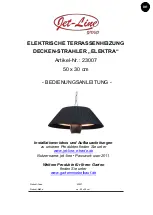
30
PIN
CONNECTION
NOTES
1-2
EXTERNAL
CONTROL
When the heater is to be controlled by a 0-10V DC analogue output from a Building Management System (BMS), the
0V line should be connected to pin 1 and the 0-10V line should be connected to pin 2.
3-6
SEQUENCING
If the heaters are to be operated in a cascade, shielded 2-wire twisted pair communication cable should be used. The
shielding should be connected to pin 3 or 6 and then all “A” terminals (pin 5) should be linked together and all “B”
terminals (pin 4) should be linked together.
7-8
TANK SENSOR
The chosen flow temperature sensor (
Section 10.6: FLOW TEMPERATURE SENSOR
) should be connected to pins
7&8. Where remote control over the water heater is required, the sensor wiring should be connected using screened
cable to a volt-free contact. The contact should be configured to close when heat is required and open to prevent the
water heater from operating. For further information, please refer to
Figure 11.3
.
9-10
TANK
THERMOSTAT
This connection should not be used. The supplied temperature sensor should be connected to pins 7&8. For further
information, please refer to
Section 10.6: FLOW TEMPERATURE SENSOR
11-12
RUNTIME
CONTACTS
An internal volt free contact across pins 11&12 will close in the event of the burner operating. This connection can be
used by a BMS to monitor the operation of the heater.
13-14
ALARM
CONTACTS
An internal volt free contact across pins 13&14 will close in the event of the heater locking out. This connection can
be used by a BMS to monitor the operation of the heater.
15-16
FLOW SWITCH
If a flow switch is to be used to ensure the primary pump is operating, the link should be taken out of pins 15&16 and
the flow switch wiring installed. If there is no continuity across the terminals the heater will not fire.
17-18
GAS PRESSURE
SWITCH
If a gas pressure switch is to be used to ensure the incoming gas pressure is correct, the link should be taken out of
pins 17&18 and the gas pressure switch wiring installed. If there is no continuity across the terminals the heater will
not fire.
19-20
AUX. PROVING
DEVICE
If an auxiliary device such as a fan dilution system or mechanical ventilation system is to be used, the link should be
taken out of pins 19&20 and the auxiliary deice safety circuit wiring installed. If there is no continuity across the
terminals the heater will not fire.
21-22
AUX. DEVICE
PILOT SUPPLY
When the heater gets a call for heat, a 24VAC supply becomes present on pin 22. Used in conjunction with the
ground pin (pin 21), these terminals can be used to send a signal to energise an auxiliary device such as a fan dilution
system or mechanical ventilation system.
TABLE 11.3
LOW VOLTAGE CONNECTION TERMINAL DETAILS
FIGURE 11.3
TIME CONTROL WIRING
AUX. DEVICE
PILOT SUPPLY
24VAC
GND
AUX. DEVICE
PROVING
GAS PRESSURE
SWITCH
FLOW
SWITCH
ALARM
CONTACTS
RUNTIME
CONTACTS
TANK
SENSOR
SHIELD GROUND
0-10VDC EXTERNAL
GND CONTROL
TANK THERMOSTAT
A
B
SHIELD GROUND
SEQUENCING
LOW
WAT
E
R
C
UTOF
F
CN1
CN2
CN3
CN4
CN5
9
10
11
12
13
14
15
16
17
18
19
20
21
22
1
2
3
4
5
6
7
8
FLOW TEMPERATURE SENSOR
CONTROL CONTACT
















































